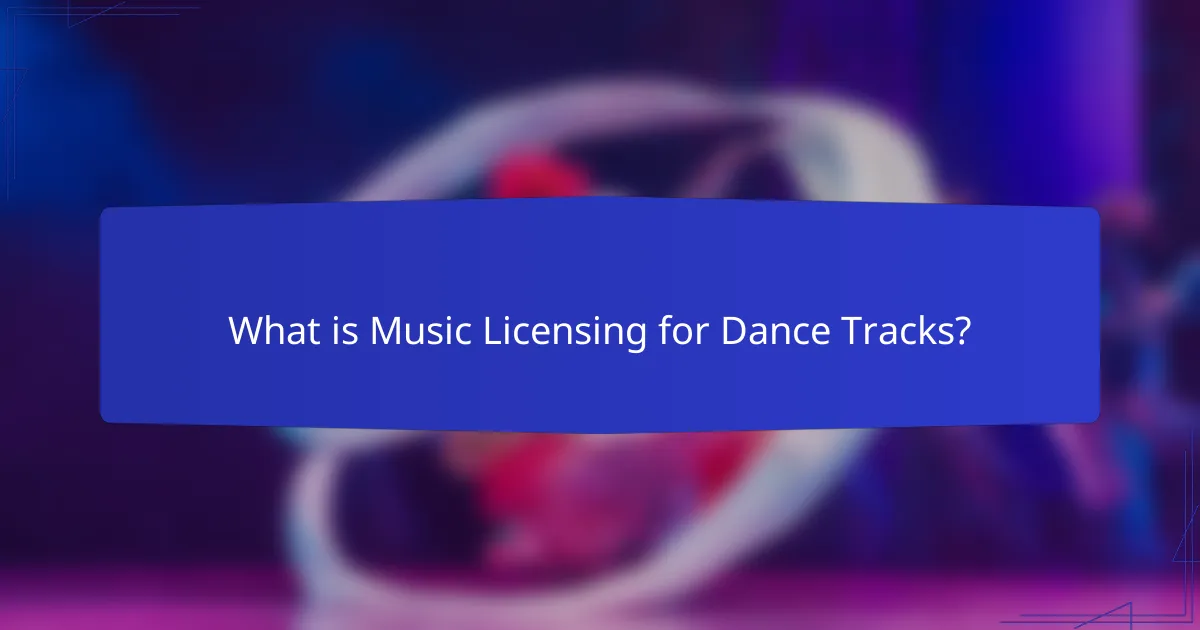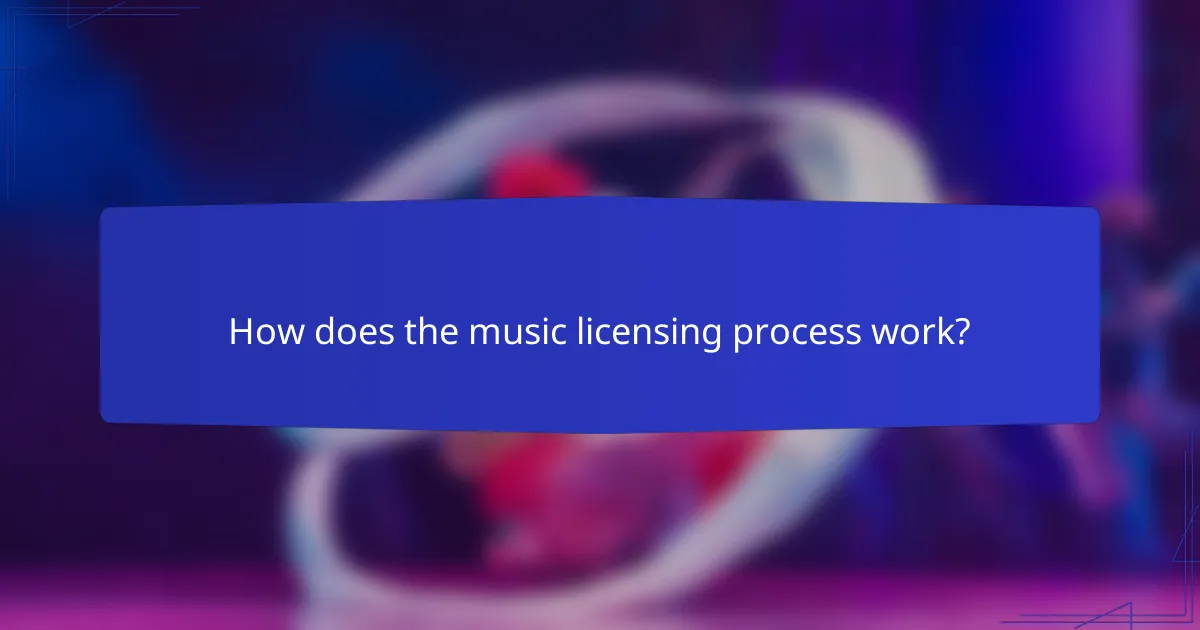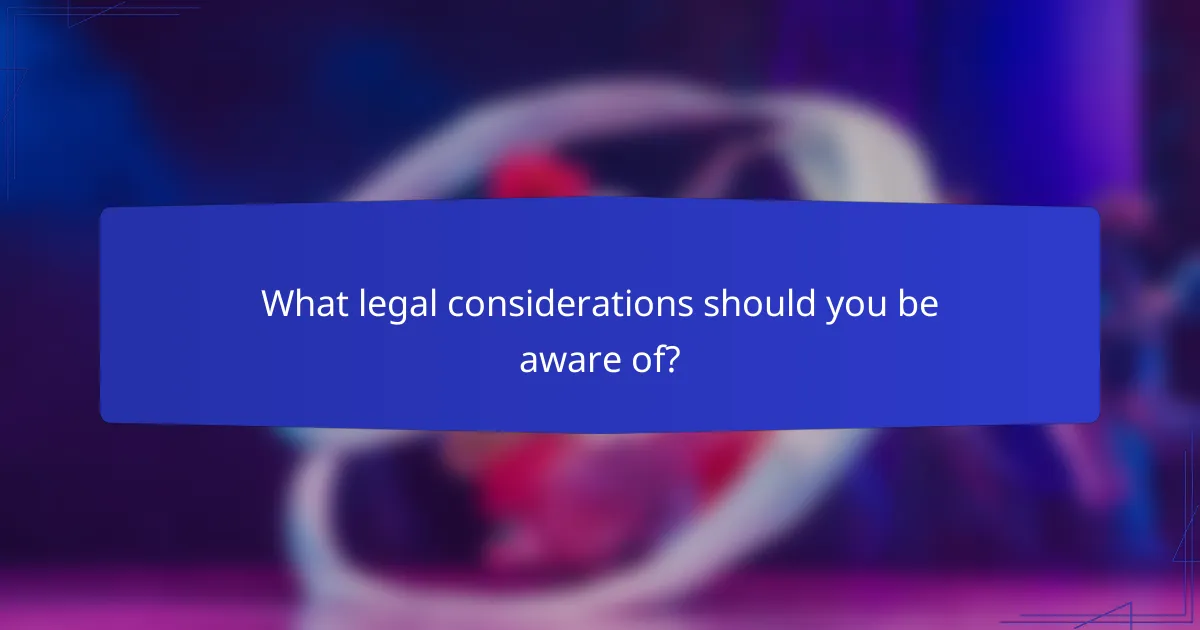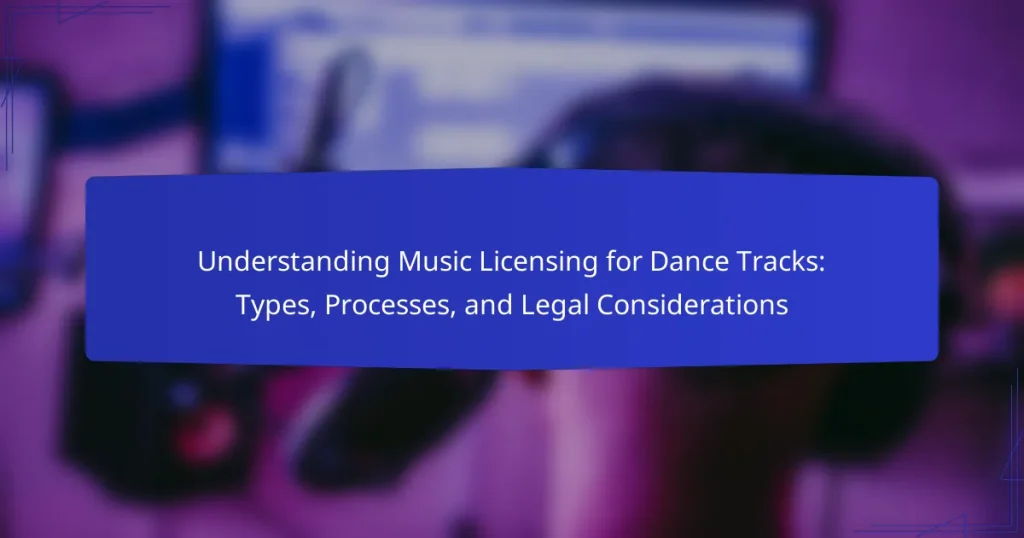Music licensing for dance tracks is a legal process that grants permission to use copyrighted music in dance-related contexts, ensuring creators receive compensation for their work. This article outlines the types of licenses involved, including synchronization licenses for visual media and public performance licenses for live events. It details the licensing process, which includes identifying rights holders, negotiating terms, and formalizing contracts. Additionally, the article highlights key legal considerations, such as copyright law, performance rights organizations, and the implications of fair use. Understanding these elements is essential for compliance and avoiding legal issues in music licensing.

What is Music Licensing for Dance Tracks?
Music licensing for dance tracks refers to the legal permission required to use a piece of music in a dance-related context. This includes obtaining rights from the original copyright holders, such as composers and record labels. Licensing ensures that creators are compensated for their work when it is used in performances, broadcasts, or recordings. Different types of licenses may apply, including synchronization licenses for videos and public performance licenses for live events. The licensing process typically involves negotiations and payment of fees based on the intended use and distribution. Without proper licensing, using dance tracks can lead to legal repercussions and financial penalties.
Why is music licensing important for dance tracks?
Music licensing is important for dance tracks to ensure legal use and protect creators’ rights. It allows artists to earn revenue from their work through royalties. Licensing also prevents copyright infringement, which can lead to legal disputes. Dance tracks often incorporate samples or elements from other songs, making licensing crucial. According to the U.S. Copyright Office, unauthorized use can result in significant penalties. Additionally, licensed music enhances the credibility of dance events and productions. It ensures that all parties involved respect intellectual property laws. Overall, music licensing safeguards both artists and users in the dance music industry.
What risks are associated with not licensing music?
Not licensing music exposes individuals and organizations to legal risks. Unauthorized use of copyrighted music can lead to copyright infringement claims. This may result in significant financial penalties. Legal action can also lead to costly litigation expenses. Additionally, businesses may face reputational damage from negative publicity. Music licensing ensures compliance with copyright laws, protecting against these risks. According to the U.S. Copyright Office, using music without a license is a violation of federal copyright law.
How does licensing protect artists and producers?
Licensing protects artists and producers by granting them legal rights to their creative works. It ensures that they receive compensation for the use of their music. Without licensing, unauthorized use can lead to financial loss. Licensing also provides a framework for legal recourse in cases of infringement. For instance, artists can pursue damages if their work is used without permission. Additionally, licensing agreements outline the terms of use, ensuring clarity for both parties. This legal structure fosters a fair environment for creators in the music industry. Overall, licensing is crucial for safeguarding the interests of artists and producers.
What are the different types of music licenses?
The different types of music licenses include mechanical licenses, synchronization licenses, performance licenses, and master licenses. Mechanical licenses allow the reproduction of music on physical media. Synchronization licenses permit the use of music in audiovisual works. Performance licenses are required for public performances of music. Master licenses grant rights to use a specific recording of a song. Each license serves a unique purpose in the music industry, ensuring creators are compensated for their work.
What is a synchronization license?
A synchronization license is a legal agreement that allows the use of a copyrighted musical work in conjunction with visual media. This includes films, TV shows, commercials, and online videos. The license grants permission from the copyright holder to synchronize the music with the visual content. It is essential for creators to obtain this license to avoid copyright infringement. Without it, using music in visual projects can lead to legal consequences. The terms of synchronization licenses can vary based on the specific use and the negotiating parties.
What is a mechanical license?
A mechanical license is a legal permission that allows the reproduction of a copyrighted musical composition. This license is typically required when a song is recorded and distributed in physical formats, such as CDs, or digital formats, like downloads. The license grants the holder the right to create copies of the song and distribute them to the public. Mechanical licenses are essential for songwriters and music publishers to receive royalties for their work. The U.S. Copyright Act of 1976 established the framework for mechanical licensing. It ensures that songwriters are compensated when their music is reproduced.
What is a performance license?
A performance license is a legal authorization that allows individuals or organizations to publicly perform copyrighted music. This type of license is essential for venues, DJs, and performers who play music in public settings. It covers various forms of public performance, including live concerts and recorded music playback. Performance licenses are typically obtained from performing rights organizations (PROs) like ASCAP, BMI, or SESAC. These organizations collect fees from licensees and distribute royalties to songwriters and publishers. The necessity of a performance license stems from copyright law, which protects the rights of creators. Without this license, public performances of copyrighted music can lead to legal repercussions.

How does the music licensing process work?
The music licensing process involves obtaining permission to use copyrighted music. It typically begins with identifying the rights holders, such as songwriters or record labels. Next, the user must determine the type of license needed, which can vary based on the intended use. Common licenses include synchronization licenses for film and mechanical licenses for physical copies.
After identifying the license type, the user contacts the rights holders or their representatives. Negotiations on terms, duration, and fees follow. Once an agreement is reached, a formal contract is drafted and signed. Payment is usually made upfront or through royalties, depending on the agreement.
This process ensures that creators are compensated for their work while allowing users to legally incorporate music into their projects.
What steps are involved in obtaining a music license?
Identify the type of music license needed. Common types include synchronization, mechanical, and performance licenses. Research the rights holder for the specific song. This may involve identifying the songwriter, publisher, or record label. Contact the rights holder to request the license. This often includes providing details about how the music will be used. Negotiate the terms of the license. This may involve discussing fees, duration, and usage rights. Review and sign the licensing agreement. Ensure all terms are clearly stated and understood. Make the payment as agreed in the contract. Retain a copy of the license for your records.
How do you identify the rights holders for a track?
To identify the rights holders for a track, start by determining the song’s authors and composers. Check databases like ASCAP, BMI, or SESAC for registered works. These organizations provide information on songwriters and publishers. Additionally, review the track’s credits on streaming platforms or physical releases. Look for details on the record label and production companies involved. Contacting these entities can clarify ownership. In some cases, legal databases or copyright offices can offer further insights into rights holders.
What information is needed to request a license?
To request a music license, specific information is required. This includes the name of the song and the artist. The intended use of the music must be clearly stated. Details about the duration of the usage are also necessary. Additionally, the distribution method should be specified. Providing contact information for the requester is essential. Any relevant deadlines for the licensing request must be included. This information ensures a smooth licensing process and aids in determining fees and rights.
What factors affect the cost of music licensing?
The cost of music licensing is influenced by several key factors. These factors include the type of music being licensed, the intended use, and the duration of the use. Popular or well-known songs typically cost more due to their demand and recognition. The specific media platform also plays a role; licensing for television or film is often more expensive than for online use. Additionally, the geographic territory where the music will be used affects pricing, as different regions may have varying licensing fees. The length of the music usage, whether it’s a short clip or a full song, further impacts the cost. Lastly, negotiations and the relationship with the rights holder can lead to variations in the final licensing fee.
How do usage type and duration impact licensing fees?
Usage type and duration significantly impact licensing fees. Different usage types, such as broadcast, public performance, or synchronization, have varying fee structures. For instance, broadcast licenses typically incur higher fees due to wider audience reach. Public performance licenses may vary based on venue size and audience capacity. Duration also plays a crucial role; longer usage periods generally result in higher fees. A study by the American Society of Composers, Authors and Publishers (ASCAP) indicates that fees can increase substantially with extended usage terms. This correlation between usage type, duration, and fees is critical for budgeting in music licensing.
What role does the popularity of the track play in licensing costs?
The popularity of a track significantly influences its licensing costs. High-demand tracks often command higher fees due to their established market value. Licensing costs reflect the track’s commercial success and audience reach. Popular tracks are more likely to generate revenue for the licensee, justifying increased costs. For example, well-known songs can attract larger audiences and higher engagement. Additionally, the popularity can lead to increased negotiation leverage for rights holders. This trend is supported by industry data showing a correlation between track popularity and licensing fees. Thus, the popularity of a track is a critical factor in determining its licensing costs.

What legal considerations should you be aware of?
When engaging in music licensing for dance tracks, several legal considerations are crucial. First, copyright law protects original music compositions. This means obtaining permission from copyright holders is necessary for legal use. Second, performance rights organizations (PROs) manage public performance rights. Artists must ensure proper licensing through these organizations for live or recorded performances. Third, synchronization licenses are required for pairing music with visual media. This is essential for films, videos, or advertisements featuring the music. Fourth, mechanical licenses are needed for reproducing music on physical media. This applies to CDs, vinyl, or digital downloads. Lastly, understanding fair use is important. Fair use allows limited use without permission, but it has strict limitations and varies by jurisdiction. These considerations are vital for compliance and avoiding legal disputes in music licensing.
What are the common legal issues in music licensing?
Common legal issues in music licensing include copyright infringement, unauthorized use, and licensing disputes. Copyright infringement occurs when music is used without permission from the rights holder. Unauthorized use can lead to legal action if a track is played publicly or distributed without a proper license. Licensing disputes often arise over terms of use, payment, and duration of the license. Additionally, there are issues related to sampling, where a portion of a song is used in another track without clearance. These problems can result in significant legal consequences, including fines and litigation. Understanding these issues is crucial for anyone involved in music licensing.
How can copyright infringement be avoided?
Copyright infringement can be avoided by obtaining proper licenses for music use. This involves identifying the type of music and its copyright status. Always seek permission from copyright holders before using their work. Utilize music that is in the public domain or licensed under Creative Commons. Additionally, consider using royalty-free music that allows legal usage without infringement. Keeping clear records of all licenses and permissions is crucial. Regularly review and update licensing agreements to ensure compliance. Following these steps significantly reduces the risk of copyright infringement.
What are the implications of using unlicensed music?
Using unlicensed music can lead to legal consequences. Copyright infringement occurs when music is used without permission. This can result in lawsuits from copyright holders. Financial penalties may be imposed on those who use unlicensed music. Additionally, unlicensed music can damage a brand’s reputation. It may also lead to the removal of content from platforms. Organizations may face restrictions on future music use. The risks associated with unlicensed music usage are significant and should be carefully considered.
How can you ensure compliance with music licensing laws?
To ensure compliance with music licensing laws, obtain the necessary licenses for any music used. This includes securing synchronization licenses for film or video, mechanical licenses for physical copies, and performance licenses for public plays. It is important to identify the copyright holder of the music, which can often be found through performing rights organizations. Additionally, keep thorough records of all licensing agreements and communications. Regularly review and stay updated on licensing laws, as they can change. Engaging a legal expert in music law can also provide guidance and ensure adherence to regulations.
What resources are available for understanding licensing regulations?
Government websites provide essential resources for understanding licensing regulations. These sites include the U.S. Copyright Office and the Performing Rights Organizations. They offer guidelines on music licensing and copyright laws. Legal textbooks and industry publications also serve as valuable resources. They explain licensing terms and processes in detail. Online courses and webinars can further enhance understanding. Many organizations offer training on music licensing. Consulting with legal professionals is another effective way to navigate regulations. They provide tailored advice based on specific licensing needs.
How can legal advice assist in the licensing process?
Legal advice can assist in the licensing process by ensuring compliance with copyright laws. It helps identify the necessary licenses required for specific dance tracks. Legal professionals can clarify contractual obligations and rights associated with the music. They can also negotiate terms with rights holders to secure favorable agreements. Additionally, legal advice mitigates risks related to infringement claims. This guidance can streamline the licensing process, making it more efficient. Accurate legal counsel can result in cost savings by avoiding potential legal disputes. Overall, legal advice is essential for navigating the complexities of music licensing effectively.
What are best practices for music licensing in dance production?
Best practices for music licensing in dance production include securing permissions before using any music. Always identify the rights holder of the track. This may be the artist, producer, or a record label. Obtain a synchronization license for using music in a visual context, such as videos or performances. Acquire a master use license if you plan to use a specific recording. Consider using royalty-free music to simplify the licensing process. Document all agreements and communications related to licensing. Stay informed about copyright laws and changes in music licensing regulations. These practices help avoid legal issues and ensure proper attribution to artists.
How can producers effectively manage their licensing needs?
Producers can effectively manage their licensing needs by establishing clear processes and utilizing technology. They should start by identifying all necessary licenses for their projects. This includes synchronization licenses for music use in videos and mechanical licenses for physical copies.
Producers must also keep accurate records of all licensing agreements. This helps in tracking renewals and compliance with terms. Utilizing licensing management software can streamline this process. Such tools often provide reminders for renewals and updates on licensing laws.
Additionally, consulting with legal experts in music licensing can ensure compliance and avoid potential disputes. Regularly reviewing industry standards and changes in copyright law is essential. This proactive approach minimizes risks and ensures that producers can focus on their creative work.
What tips can help streamline the licensing process?
To streamline the licensing process, maintain organized documentation of all necessary materials. This includes contracts, agreements, and any required permissions. Additionally, clearly identify the rights needed for your specific use case. This reduces confusion and potential delays. Establish communication with rights holders early in the process. Timely responses can significantly speed up negotiations. Utilize licensing platforms that simplify the process and provide clear guidance. According to a study by the Music Licensing Coalition, efficient communication can reduce licensing time by up to 30%.
Music licensing for dance tracks is the legal permission required to use music in dance-related contexts, ensuring creators receive compensation for their work. This article covers the importance of music licensing, the risks of not obtaining licenses, and the various types of licenses, including synchronization, mechanical, and performance licenses. It also outlines the music licensing process, factors affecting licensing costs, and common legal considerations, providing a comprehensive guide for artists and producers in the dance music industry. Understanding these elements is crucial for compliance and protecting intellectual property rights.

